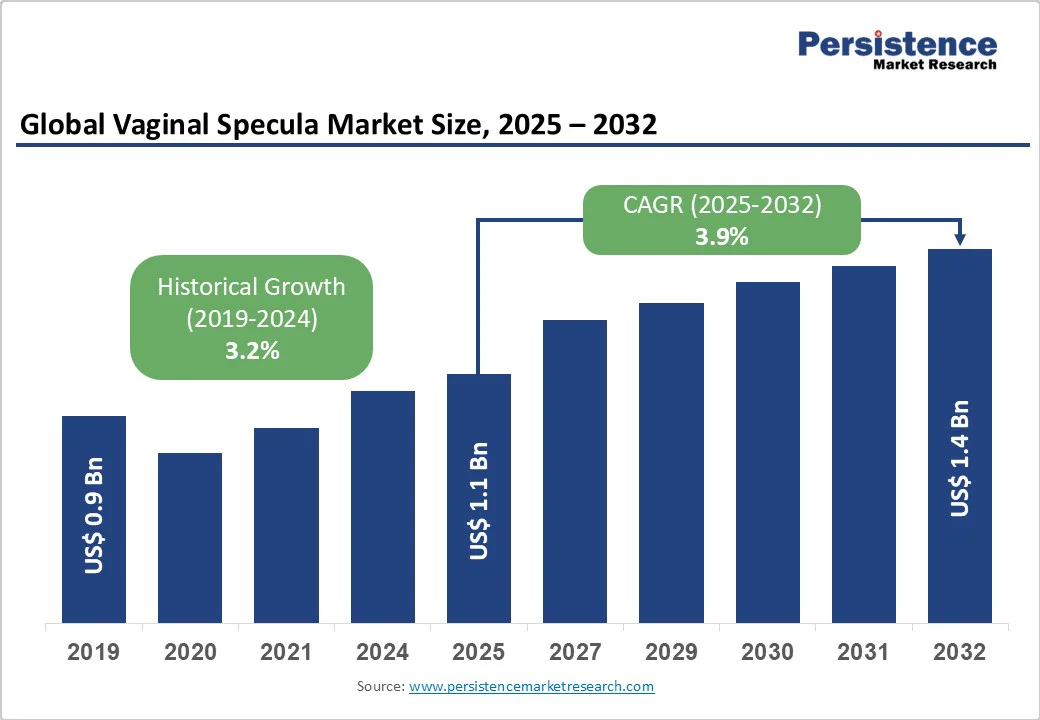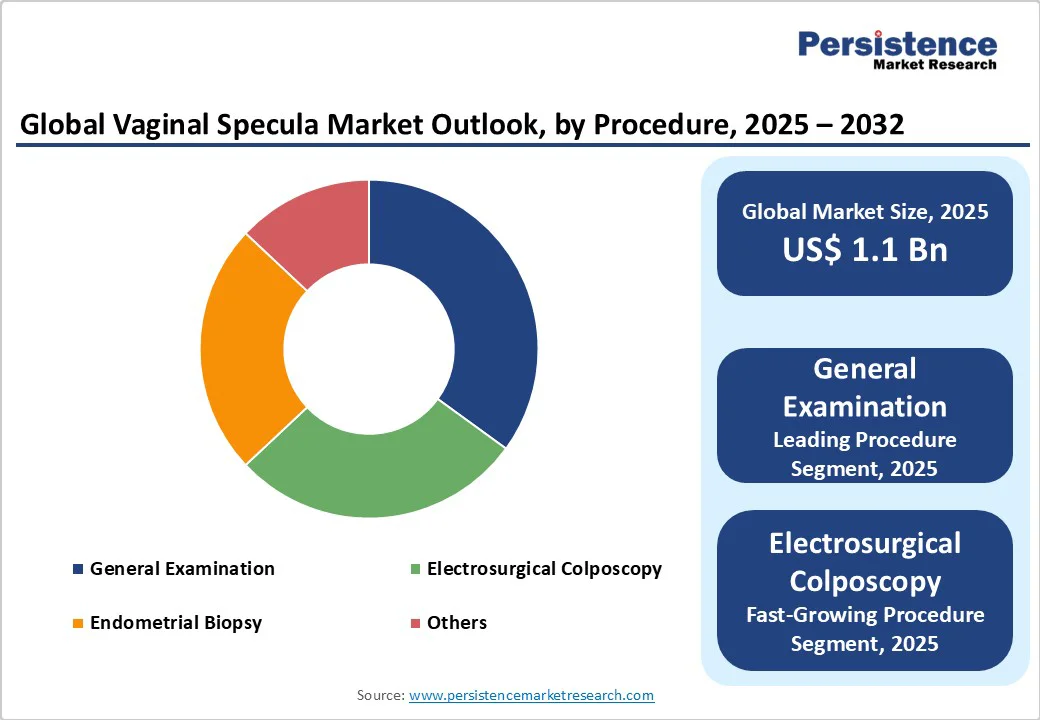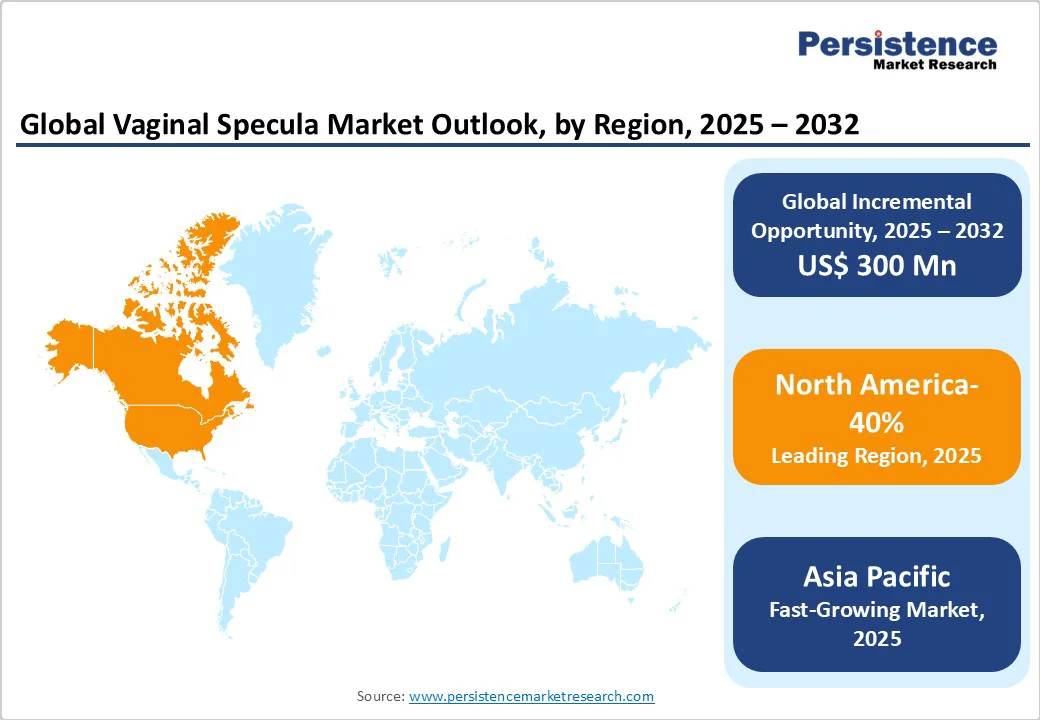ID: PMRREP33717| 178 Pages | 10 Oct 2025 | Format: PDF, Excel, PPT* | Healthcare

The global vaginal specula market size is likely to be valued at US$1.1 billion in 2025 and is expected to reach US$1.4 billion by 2032, growing at a CAGR of 3.9% during the forecast period from 2025 to 2032.
Rising cervical cancer cases and growing awareness of women’s health are driving market growth. Increased preventive screenings, routine gynecological examinations, and wider use of disposable specula for infection control are fueling demand.
| Key Insights | Details |
|---|---|
| Vaginal Specula Market Size (2025E) | US$1.1 Bn |
| Market Value Forecast (2032F) | US$1.4 Bn |
| Projected Growth (CAGR 2025 to 2032) | 3.2% |
| Historical Market Growth (CAGR 2019 to 2024) | 3.9% |

The rising prevalence of cervical cancer is a major driver for the vaginal specula market, as these devices are indispensable in gynecological examinations and screening. Cervical cancer is identified as the fourth most common cancer in women globally, with a significant disease burden in low- and middle-income regions.
Public health programs have intensified screening initiatives, with millions of women undergoing tests such as Visual Inspection with Acetic Acid (VIA). For instance, under India’s National Health Mission, more than 10 crore women aged 30-65 years have already been screened for cervical cancer. These large-scale initiatives underscore the increasing reliance on vaginal specula as a vital tool for accurate diagnosis and early detection.
In parallel, women’s health awareness is increasing through government campaigns that emphasize prevention, education, and timely screening. Programs under national non-communicable disease control frameworks promote regular gynecological check-ups, encouraging women to prioritize cervical health. This heightened awareness, combined with the growing disease prevalence, is fueling strong demand for vaginal specula worldwide.
A major restraint for the vaginal specula market is the risk of infection, especially when reusable devices are not properly sterilized. Any lapse in disinfection can increase the chance of cross-contamination during gynecological examinations. While single-use disposable specula help minimize this risk, their higher costs and environmental concerns restrict widespread adoption, creating challenges for both healthcare providers and manufacturers.
Additionally, stringent regulatory requirements pose significant hurdles for market players. Vaginal specula are classified as medical devices and must comply with strict safety and quality standards, which vary across regions. The lengthy approval processes and high compliance costs delay product launches, limiting participation from smaller companies and thereby slowing overall market expansion.
Innovations in disposable vaginal specula are creating significant opportunities, as healthcare providers increasingly prioritize patient safety and infection control. Advances in design, such as ergonomically shaped, lightweight, and transparent disposable specula, enhance comfort during examinations while reducing the risk of cross-contamination. Furthermore, the shift toward eco-friendly, biodegradable materials is addressing sustainability concerns, making disposable options more acceptable in regions with strict medical waste regulations.
Emerging markets present another strong growth avenue, driven by rising healthcare infrastructure investments, expanding hospital networks, and increasing awareness of women’s health. Countries in the Asia Pacific, Latin America, and parts of Africa are experiencing a growing demand for cost-effective screening tools, driven by government programs and private healthcare expansion. This growing accessibility to gynecological care is expected to drive widespread adoption of disposable specula in these regions.
Disposable specula are expected to dominate the vaginal specula market in 2025, accounting for nearly 55% of the total share. Their growing preference is largely attributed to enhanced infection control, convenience, and reduced need for sterilization processes.
Unlike reusable metal specula, disposable variants minimize the risk of cross-contamination, making them highly suitable for busy clinical settings and large-scale screening programs. This advantage has positioned them as the preferred choice for healthcare providers worldwide.
Disposable specula represent the fastest-growing segment. Advancements in product design, the use of lightweight materials, and the availability of eco-friendly, biodegradable alternatives are accelerating demand. These options not only support regulatory compliance but also offer cost savings by reducing the need for sterilization. Their rising adoption across developed healthcare systems and expanding access in emerging economies will continue to reinforce their market growth trajectory.
In 2025, general examination is expected to hold the largest share of the vaginal specula market, accounting for about 35%. This is primarily due to the extensive use of specula in routine gynecological assessments, Pap smear tests, and other basic diagnostic procedures.
With growing awareness of women’s health and increasing emphasis on preventive care, the demand for specula in everyday examinations remains strong. Their indispensable role in primary and secondary healthcare settings further secures their dominance in this segment.
Electrosurgical colposcopy is forecasted to be the fastest-growing application area. The rising incidence of cervical disorders and greater reliance on advanced diagnostic and treatment methods are fueling its adoption. As healthcare facilities continue to prioritize accuracy and effective management of precancerous conditions, the use of vaginal specula in electrosurgical colposcopy is expanding rapidly, driving significant growth within this segment.
Hospitals and clinics are projected to dominate the vaginal specula market in 2025, holding nearly 60% of the total share. Their dominance stems from the high volume of gynecological procedures performed in these settings, including routine examinations, Pap smears, and cervical cancer screenings.
Equipped with advanced diagnostic infrastructure and staffed by specialists, hospitals and clinics remain the primary point of care for women’s health services. The growing focus on preventive healthcare and organized screening programs further supports their leading position.
Ambulatory surgical centers (ASCs) are anticipated to be the fastest-growing end-use segment. The increasing shift toward minimally invasive procedures, shorter patient stays, and cost-effective treatment options is boosting demand for ASCs. As these facilities expand their capabilities in gynecology and women’s health, the adoption of vaginal specula in ambulatory care settings is expected to rise significantly, fueling rapid market growth.

North America is expected to hold the largest share of the vaginal specula market in 2025, accounting for approximately 40% of the global revenue. The region’s leadership is driven by strong healthcare infrastructure, widespread access to gynecological care, and high participation in cervical cancer screening programs.
Supportive government initiatives and the presence of leading medical device manufacturers also reinforce its position. Additionally, the growing use of disposable specula, encouraged by stringent infection prevention standards, is contributing to a steady demand. With the adoption of advanced technology and a strong focus on women’s health, North America is poised to maintain its dominance during the forecast period.
Europe holds a notable share of the vaginal specula market, supported by well-established healthcare systems and a strong emphasis on women’s health. Regular cervical cancer screening programs, particularly in countries such as the UK, Germany, and France, have contributed to steady demand for specula in clinical practice.
The region also benefits from stringent regulatory standards that ensure high product quality and safety, encouraging the adoption of advanced disposable options. With rising awareness, favorable government initiatives, and continuous improvements in healthcare infrastructure, Europe is expected to remain an important contributor to the overall market throughout the forecast period.
The Asia Pacific is projected to be the fastest-growing market for vaginal specula, driven by increased awareness of women’s health and the expansion of healthcare infrastructure. Rising government-led initiatives for cervical cancer screening, the greater adoption of disposable specula, and the growth of private healthcare facilities are fueling market demand.
Countries such as China, India, and Japan are witnessing increased participation in routine gynecological examinations, presenting significant growth potential. With a large population and improving access to quality healthcare, ongoing technological advancements and rising healthcare investments are expected to sustain strong market expansion in the coming years.

The global vaginal specula market is highly competitive, driven by continuous product innovation, quality improvements, and compliance with stringent regulatory standards. Companies are focusing on developing advanced disposable and ergonomically designed specula to enhance patient comfort and safety.
Market players are also investing in expanding their distribution networks, enhancing manufacturing capabilities, and adopting sustainable materials. Strategic collaborations, partnerships, and product launches are common strategies for strengthening market presence and addressing the growing demand across hospitals, clinics, and emerging healthcare markets globally.
The vaginal specula market is projected to reach US$1.1 bn in 2025, driven by cervical cancer screenings and women’s health initiatives.
Rising cervical cancer cases, increased screening rates, and advanced speculum designs fuel market growth.
The vaginal specula market will grow from US$1.1 bn in 2025 to US$1.4 bn by 2032, with a CAGR of 3.9%.
Innovations in disposable specula and expansion in emerging markets drive opportunities in infection control and accessibility.
Leading players include OBP Medical, CooperSurgical, B. Braun Melsungen AG, Welch Allyn, Pelican Feminine Healthcare, Crown Holdings Inc., DYNAREX Corporation, MedGyn, Integra Lifesciences, Sklar Surgical, Steris, Teleflex Inc., and Robinson Healthcare.
| Report Attribute | Details |
|---|---|
| Historical Data/Actuals | 2019 - 2024 |
| Forecast Period | 2025 - 2032 |
| Market Analysis | Value: US$ Bn, Volume: As Applicable |
| Geographical Coverage |
|
| Segmental Coverage |
|
| Competitive Analysis |
|
| Report Highlights |
|
By Usage Type
By Procedure
By End-use
By Region
Delivery Timelines
For more information on this report and its delivery timelines please get in touch with our sales team.
About Author